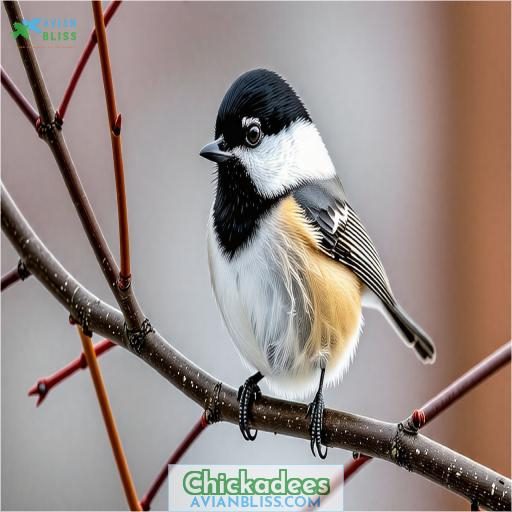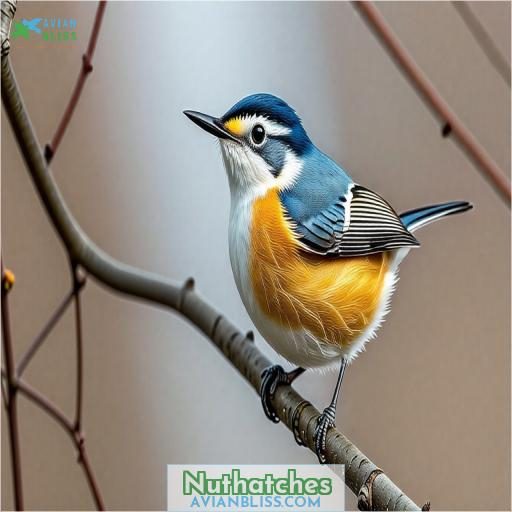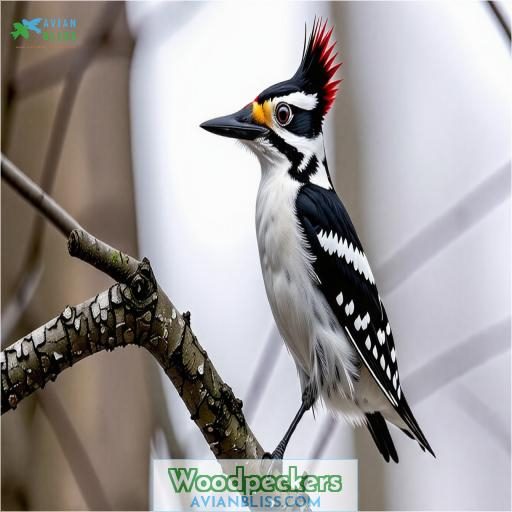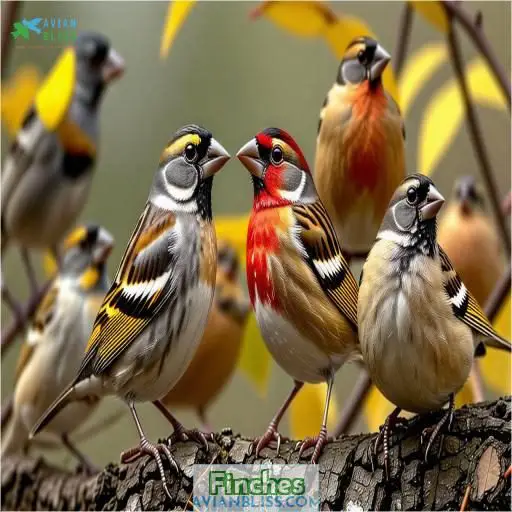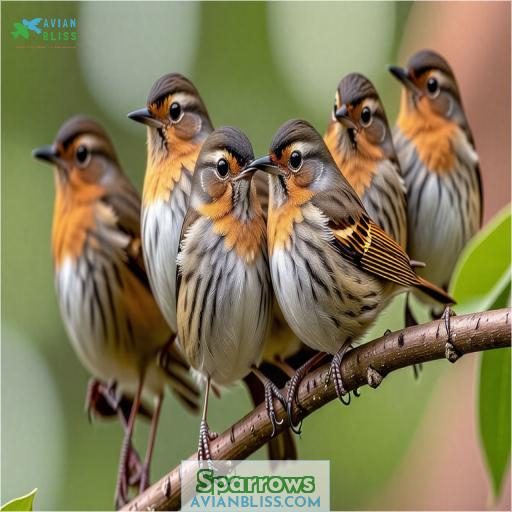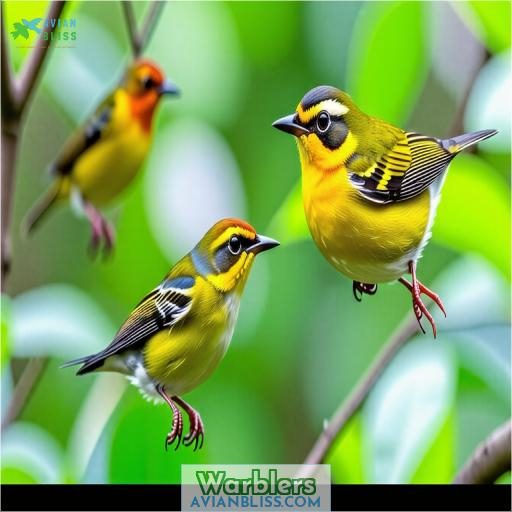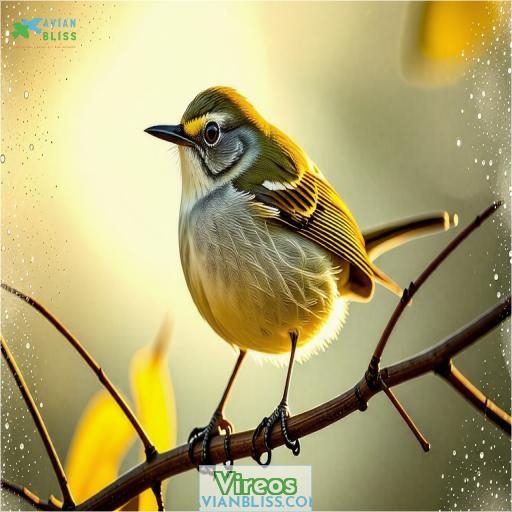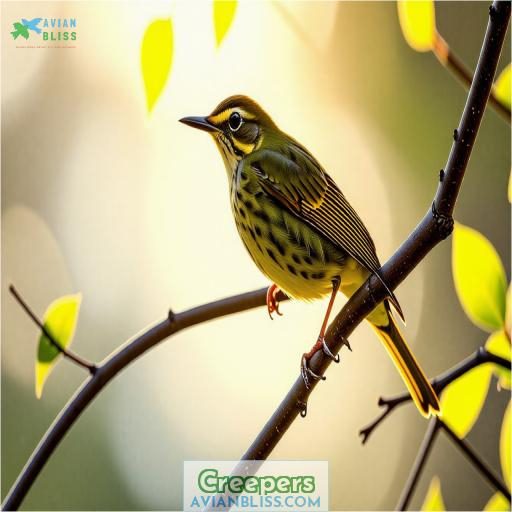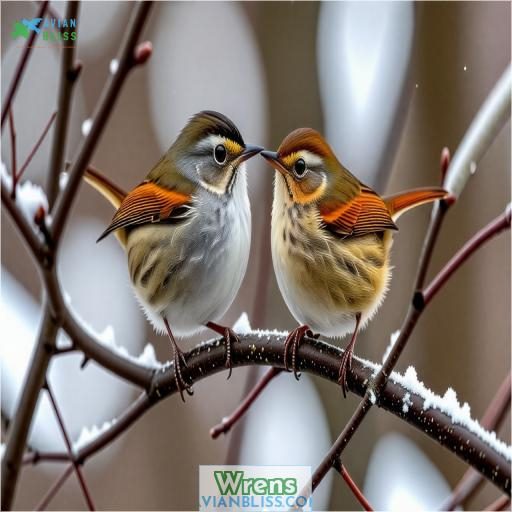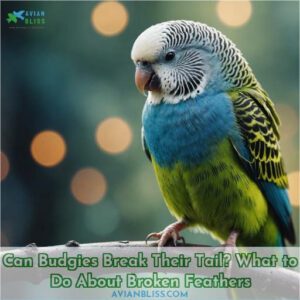This site is supported by our readers. We may earn a commission, at no cost to you, if you purchase through links.
 You’re in for a treat, bird enthusiast!
You’re in for a treat, bird enthusiast!
Wisconsin’s backyard oasis is a haven for an array of enchanting small birds.
From the chickadees’ cheery chants to the nuthatches’ spunky antics, you’ll be entertained endlessly.
Keep an eye out for woodpeckers drumming on trees, while colorful finches and sparrows flit about in search of seeds.
These feathered wonders will leave you in awe with their intricate songs and lively displays.
But why stop at a mere glimpse when you can immerse yourself in their magical world?
Table Of Contents
- Key Takeaways
- Chickadees
- Nuthatches
- Woodpeckers
- Finches
- Sparrows
- Warblers
- Vireos
- Kinglets
- Creepers
- Wrens
- Frequently Asked Questions (FAQs)
- How do I identify a bird in my yard?
- What sparrows are in Wisconsin?
- What is the most popular bird in Wisconsin?
- What are the tiny birds that hop around?
- What are the most common small birds found in Wisconsin?
- How do small birds survive harsh Wisconsin winters?
- What can I do to attract small birds to my garden in Wisconsin?
- What are the typical nesting and breeding behaviors of small birds in Wisconsin?
- Are there any specific threats or predators that small birds face in Wisconsin?
- Conclusion
Key Takeaways
- Wisconsin’s backyards are home to a diverse array of small birds, including chickadees, nuthatches, woodpeckers, finches, sparrows, warblers, vireos, kinglets, creepers, and wrens.
- These birds exhibit a wide range of behaviors, from the acrobatic foraging of nuthatches to the vibrant plumage and songs of warblers and finches.
- Providing food, water, and shelter can attract many of these species to backyard feeders and gardens, offering opportunities for birdwatching and photography.
- Protecting habitats, reducing threats like window collisions and cat predation, and supporting conservation efforts can help ensure the continued presence of these delightful small birds in Wisconsin’s landscapes.
Chickadees
You’re most likely to encounter two species of chickadees in Wisconsin’s backyards and woodlands: the familiar black-capped chickadee with its iconic black cap and bib contrasting against gray upperparts, and the more northern boreal chickadee, slightly smaller with a brown cap and rusty sides. Both are active, curious songbirds that flit about searching for insects and seeds amid the branches.
Black-capped Chickadee
The cheerful black-capped chickadee is a beloved backyard visitor across Wisconsin.
Its distinctive black cap, white cheeks, and gray back make it easy to identify at bird feeders.
Listen for its iconic chick-a-dee-dee-dee call and watch as it nimbly forages for insects and seeds in deciduous and mixed forests.
Attract these curious little birds by offering sunflower seeds and suet at your feeders.
Boreal Chickadee
The Boreal Chickadee, a hardy resident of the northern boreal forests, thrives in its winter habitat.
This small bird forages acrobatically, gleaning insects and seeds from coniferous trees.
Nesting in tree cavities, the Boreal Chickadee lays 5-8 eggs and raises its young with its distinctive, nasal chick-a-dee-dee-dee calls.
A close relative of the Black-capped Chickadee, the Boreal Chickadee is a fascinating member of the chickadee family.
Nuthatches
Nuthatches are compact, agile birds known for their ability to climb vertically up and down tree trunks and branches. Their distinctive behavior, coupled with bold facial patterns and nasal calls, make the White-breasted Nuthatch and Red-breasted Nuthatch two of the most recognizable backyard visitors in Wisconsin.
White-breasted Nuthatch
The white-breasted nuthatch is a delightful backyard visitor in Wisconsin. These agile birds forage headfirst down tree trunks, probing bark crevices for insects and seeds (Source). They often join mixed flocks with chickadees and woodpeckers . Listen for their nasal yank yank calls and watch them stash seeds in bark . Put out suet and nuts to attract these charming little birds to your feeder .
| Trait | Description |
|---|---|
| Size | Slightly larger than a sparrow, 5.1-5.5 inches long |
| Plumage | Gray back, white face and underparts, black crown (males) or gray crown (females) |
| Behavior | Creeps headfirst down tree trunks, joins mixed flocks in winter |
| Vocalizations | Nasal yank yank calls, loud for their size |
Red-breasted Nuthatch
The Red-breasted Nuthatch, a charming small bird in Wisconsin, is known for its seed preferences, aiding winter survival. Regarding mating habits, they exhibit monogamous behavior. These birds are gradually expanding their range in Wisconsin, adding color and liveliness to backyard birdwatching. With their distinctive red breasts, Red-breasted Nuthatches make delightful additions to the avian fauna in Wisconsin.
- Seed preferences
- Winter survival strategies
- Monogamous mating habits
- Range expansion in Wisconsin
- Distinctive red-breasted appearance
Woodpeckers
Woodpeckers are small, stocky birds easily identified by their stiff tail feathers and chisel-like beaks designed for drilling into tree bark. The three most common woodpecker species you’ll likely encounter in your Wisconsin backyard are the downy woodpecker, the slightly larger hairy woodpecker, and the striking red-bellied woodpecker, named for its reddish belly and back.
Downy Woodpecker
The diminutive Downy Woodpecker, a common backyard visitor, sports a striking black-and-white plumage. These tree-climbing acrobats use their sharp bills to excavate nesting cavities and forage for insects, sap, and berries. Their distinctive drumming on trees serves as a territorial call. Downys are easily attracted to suet feeders, offering birdwatchers and photographers delightful close-up views of these charismatic little birds.
Hairy Woodpecker
The hairy woodpecker is a medium-sized bird with a long, straight bill and stiff tail feathers that help it climb tree trunks. It forages for insects in bark crevices and drums on trees to communicate and attract mates. Hairies nest in tree cavities and prefer mature forests, parks, and suburban areas with large trees .
- Look for the hairy’s square head, long bill, and black-and-white plumage.
- Listen for its loud, sharp calls and rapid drumming on trees.
- Spot hairies climbing up tree trunks and probing bark for food.
Red-bellied Woodpecker
The Red-bellied Woodpecker, a colorful New World woodpecker, has shown remarkable range expansion, favoring woodlands and urban areas across the eastern U.S.
Its nesting behavior involves excavating cavities in dead trees.
While during winter, it consumes insects, seeds, and fruits.
To spot this vibrant bird, explore birdwatching spots and consider investing in suitable birdwatching equipment to enjoy these backyard wonders.
Finches
Finches are small, seed-eating birds with conical bills well-suited for cracking open tough husks. You’re likely to spot the cheery red plumage of male house finches at backyard feeders, or hear the bright, trilling song of the streaky purple finch perched high in the trees.
House Finch
The House Finch, a common backyard bird, sports a red head and breast in males. These adaptable finches thrive in urban areas, readily visiting feeders for sunflower seeds. Listen for their cheerful warbling songs year-round. House Finches nest in diverse sites like trees, shrubs, and even hanging planters, raising multiple broods annually.
- Compact, finch-like body with a short, conical bill
- Bright red head and breast in males, brown in females
- Frequent visitors to backyard feeders, especially for sunflower seeds
- Melodious, varied songs heard throughout the year
Purple Finch
The Purple Finch, often mistaken for a House Finch, boasts a distinctive raspberry-red head and breast in males. Its conical beak is perfect for cracking open seeds. Listen for its warbling, flute-like song in spring. These finches migrate south in winter, seeking backyard feeders and weedy fields. Protect them from hawks and thrushes by providing dense shrubs for cover.
American Goldfinch
The American Goldfinch, a member of the finch family, is a delightful sight in Wisconsin backyards. Its bright yellow plumage and black cap make it easily recognizable. Goldfinches feed on thistle seeds, nyjer, and sunflower seeds. They build cup-shaped nests in shrubs and trees, often using plant down and spider webs. Their cheerful potato-chip song is a welcome sound in summer.
- Goldfinches are known for their bright yellow plumage and black cap
- They feed on thistle seeds, nyjer, and sunflower seeds
- Goldfinches build cup-shaped nests in shrubs and trees using plant down and spider webs
- Their cheerful potato-chip song is a delightful sound in summer
Sparrows
Sparrows are a diverse group of small songbirds, many of which can be found in backyards and parks across Wisconsin. From the streaky brown plumage of the American Tree Sparrow to the distinctive white throat pattern of the White-throated Sparrow, these hardy birds are a delight to observe as they flit among shrubbery and forage for seeds on the ground.
American Tree Sparrow
The American Tree Sparrow, a winter visitor from the Arctic, graces Wisconsin’s backyards from October to April.
Its rusty cap, dark spot on its white breast, and double white wing bars make it easy to spot among the leaf warblers and snow buntings.
These hardy sparrows survive winter by foraging on seeds and roosting communally in dense shrubs.
Look for them in open areas with scattered trees and shrubs.
Chipping Sparrow
The chipping sparrow, a common backyard bird in Wisconsin, is easily recognized by its rusty cap, dark eye line, and double white wing bars. Its cheerful chip-chip-chip song is a familiar sound in spring and summer. These small sparrows prefer open habitats like lawns, parks, and woodland edges, where they forage for seeds and insects.
- Listen for their rapid, high-pitched trills in early morning hours
- Spot them hopping on the ground or perching on low branches
- Attract them to your yard with nyjer seed or millet in feeders
- Watch for their cup-shaped nests built in shrubs or low trees
Field Sparrow
The Field Sparrow’s distinctive bouncing ball song echoes through shrubby fields and pastures across southern Wisconsin.
These small, slender sparrows with pink bills and white eye rings breed in dry, open areas with scattered trees and shrubs.
Listen for their lively calls and watch for them hopping on the ground, gleaning seeds and insects.
With a little patience, you can spot these charming backyard birds!
Song Sparrow
The Song Sparrow, known for its melodic chirping, builds cup-shaped nests in dense shrubs or vegetation near water . It’s a ground forager, feeding on seeds, insects, and spiders, while also eating berries in winter (Source). With distinctive streaks on its underparts, the Song Sparrow exhibits different color morphs across its range, with feathers adapted to various habitats (Source).
White-throated Sparrow
The white-throated sparrow is a striking bird with a white throat, yellow lores, and a black and white striped crown. It breeds in coniferous and mixed forests across Canada and the northeastern U.S., nesting on the ground. In winter, it forages in flocks, eating seeds and insects. Its clear, whistled song is a harbinger of spring.
Dark-eyed Junco
You’ll often spot the slate-colored junco, a familiar snowbird, foraging on the ground under your feeders. With its gray hood, white belly, and pinkish bill, this sparrow flashes its white outer tail feathers in flight. Listen for its distinctive trills and chips as it scratches for seeds alongside gulls and other ground feeders.
Warblers
Among the small warblers you may spot in Wisconsin’s backyards are:
The bright yellow beauty known as the Yellow Warbler.
The appropriately named Common Yellowthroat with its distinctive coal-black mask.
The striking American Redstart—a species that flashes its brilliant orange patches and black-and-white markings as it acrobatically maneuvers through tree branches in search of insects.
These lively, vibrantly colored songbirds are a treat to observe during their spring and summer breeding seasons.
Yellow Warbler
The bright yellow Yellow Warbler is a common sight in Wisconsin during spring and summer. These small songbirds breed in wet thickets and woodlands, constructing cup-shaped nests in shrubs. In fall, they migrate to wintering grounds in Central and South America. While populations are stable, habitat loss and brood parasitism by cowbirds remain conservation concerns for this beloved backyard bird.
Common Yellowthroat
The Common Yellowthroat is a vibrant warbler found in Wisconsin. Its habitat includes marshes, wetlands, and thickets. These birds nest on or near the ground, constructing cup-shaped nests. Their diet consists of insects and spiders. The Common Yellowthroat is known for its distinctive witchety-witchety-witchety song. Identification is aided by their yellow throat and black mask. They aren’t related to terns, herons, ibises, spoonbills, or owls.
Key Points:
- Habitat: Marshes, wetlands, thickets
- Nesting: Ground or near-ground nests
- Diet: Insects and spiders
American Redstart
You’ll often spot the American Redstart, a striking warbler with black and orange markings, flitting through your backyard.
These energetic birds migrate long distances, arriving in spring to nest in shrubby areas and woodlands.
Watch for their distinctive fanned tails as they flit from branch to branch, snatching insects and berries.
Their lively presence adds a vibrant touch to any outdoor space.
Vireos
When scanning the treetops for small, active birds, you’ll want to keep an eye out for the red-eyed vireo and warbling vireo. With their olive-green upperparts and sharp bills, these insect-eating songbirds are easily recognizable as they flit through the branches in search of caterpillars and other prey.
Red-eyed Vireo
The red-eyed vireo is a common summer resident in Wisconsin’s deciduous forests. Its olive-green back, white underparts, and distinctive head pattern make it easy to identify. These vireos forage actively among the leaves, gleaning insects. They build a compact, hanging nest in a tree fork. Their incessant song, a series of short phrases, is a familiar sound of summer woodlands .
Warbling Vireo
The Warbling Vireo, known for its melodious song, typically builds its nest in deciduous trees. This species thrives in wooded habitats and often forms alliances with other bird species for protection. During migration, Warbling Vireos may join mixed-species flocks, sometimes even tagging along with Tyrant Flycatchers. Observing these charming birds in action can provide a sense of intimacy with nature.
- Melodious song
- Deciduous tree nests
- Alliances with bird species
Kinglets
The Golden-crowned Kinglet and Ruby-crowned Kinglet are two tiny songbirds you might spot flitting through your backyard trees and shrubs. These energetic little foragers have striking crowns of contrasting colors—bright yellow or ruby red—which they can raise or lower to display during courtship or confrontations.
Golden-crowned Kinglet
The Golden-crowned Kinglet is a tiny, energetic bird with a bright yellow crown and black eyebrows. These insect-eaters migrate through Wisconsin in spring and fall, often in mixed flocks with chickadees and nuthatches. Look for them flitting high in coniferous trees, gleaning insects from the branches. Their high-pitched tsee calls give away their presence.
Ruby-crowned Kinglet
The ruby-crowned kinglet is a tiny, energetic bird that flits through Wisconsin’s forests and backyards. Its distinctive white eye-ring and ruby crown patch (usually concealed) make it easy to identify. These kinglets are migratory, arriving in spring to nest in coniferous forests and feed on insects. Their cheerful song, a series of high-pitched notes, is a delight to hear.
- Look for ruby-crowned kinglets in mixed deciduous-coniferous woods.
- Listen for their lively, high-pitched calls and songs.
- Enjoy watching these tiny birds forage for insects in the treetops.
Creepers
Brown Creepers are small, cryptic birds that blend seamlessly into the bark of trees.
These nimble climbers use their slender, curved bills to probe crevices for insects and spiders.
Brown Creepers inhabit mature, mixed forests, often foraging on the trunks of tall trees.
Their camouflage and quiet demeanor make them easy to overlook, but listen for their high-pitched, thin calls and watch for their unique flight pattern.
They fly to the base of one tree, then spiral up the trunk before flying down to the bottom of another tree to repeat the process.
Wrens
You’re likely to encounter two types of wrens in your Wisconsin backyard – the House Wren and the Winter Wren. The House Wren is a lively, brown bird that nests in cavities and constructs intricate nests with small twigs, while the Winter Wren, though similarly colored, is more secretive and prefers dense thickets and brushy areas.
House Wren
The House Wren is a small bird found in a variety of habitats, including forests, woodlands, and suburban areas, throughout Wisconsin.
It is known for its lively behavior, including vigorous singing and nest-building.
The diet of the House Wren primarily consists of insects.
They nest in cavities, often using nest boxes or old woodpecker holes.
Their energetic nature provides an enchanting sight in the backyard.
Winter Wren
The Winter Wren is a tiny, energetic bird with a big voice. Its dark brown plumage and short, upturned tail are distinctive. These wrens thrive in dense, moist forests, hopping among fallen logs and vegetation in search of insects. Their bubbly, trilling songs echo through the woods in spring. Nests are built in cavities close to the ground.
Frequently Asked Questions (FAQs)
How do I identify a bird in my yard?
Like solving a nature’s puzzle, observing key traits—color, pattern, size, behavior—unlocks bird identification. Sharpen your skills by practicing with local field guides; embrace the excitement of discovering avian wonders in your backyard oasis.
What sparrows are in Wisconsin?
Some common sparrows you’ll find in Wisconsin are the song sparrow, chipping sparrow, field sparrow, and the white-throated sparrow. Their cheerful chirps add a delightful soundtrack to outdoor adventures.
What is the most popular bird in Wisconsin?
Our feathered friends, the American Robin and Black-capped Chickadee, capture hearts with their endearing melodies and bold spirits. These resident birds symbolize Wisconsin’s vibrant outdoor heritage, delighting nature enthusiasts across the state.
What are the tiny birds that hop around?
You’ll often see petite songbirds like house finches, song sparrows, and chickadees hopping about on lawns or at feeders. These tiny, energetic birds flit from place to place, constantly foraging for seeds and insects.
What are the most common small birds found in Wisconsin?
To investigate, the most common tiny birds flitting in Wisconsin are house sparrows, dark-eyed juncos, chickadees, and goldfinches. These resilient feathered foragers delight with cheerful chirps while scavenging seeds.
How do small birds survive harsh Wisconsin winters?
You’ll find small birds like juncos and finches fl■ up, relying on shelter and food caches to endure frigid temps. Their insulating feathers, increased metabolism, and snow-digging skills help conserve energy during these harsh conditions.
What can I do to attract small birds to my garden in Wisconsin?
Provide a water source, plant dense shrubs for nesting, offer nesting boxes, and supply high-energy foods like suet, nuts, and seeds.
What are the typical nesting and breeding behaviors of small birds in Wisconsin?
Small birds construct intricate nests for breeding between April-August. A chickadee can build hundreds of nests before finding the perfect cavity. Monitor activity to enjoy their industrious nesting behaviors.
Are there any specific threats or predators that small birds face in Wisconsin?
Small birds face threats from cats, squirrels, snakes, and larger birds of prey. Windows, cars, and habitat loss also endanger these delicate creatures. Taking steps like keeping cats indoors, providing nest boxes, and planting native plants can help protect them.
Conclusion
Relish these backyard wonders, for they’re nature’s timeless gift. As you marvel at small birds in Wisconsin, from vibrant finches to acrobatic nuthatches, may your soul find solace in their delightful melodies and intricate dances. Embrace the chance to immerse yourself in this avian paradise, observing intricacies that showcase the profound beauty of our feathered companions.

